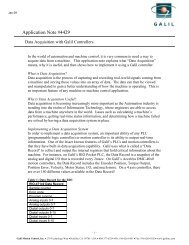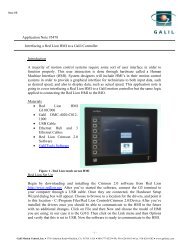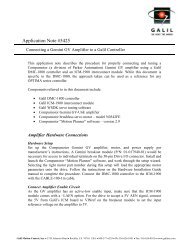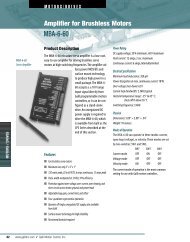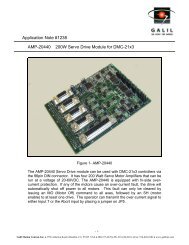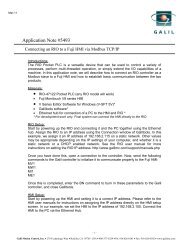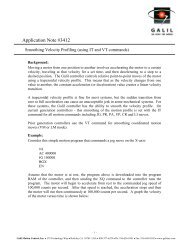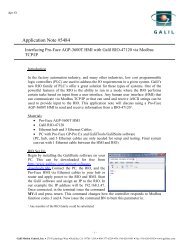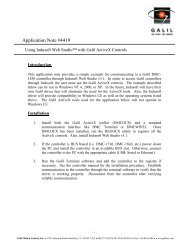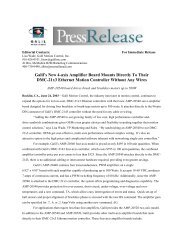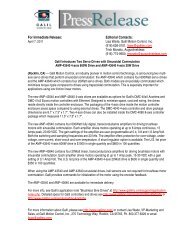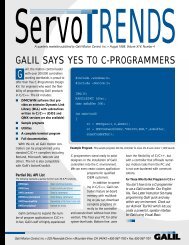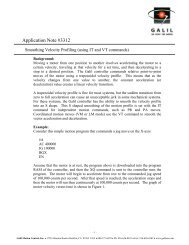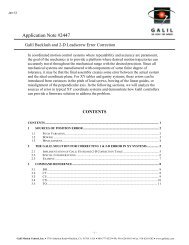Motion Control for the Newcomer - Galil
Motion Control for the Newcomer - Galil
Motion Control for the Newcomer - Galil
You also want an ePaper? Increase the reach of your titles
YUMPU automatically turns print PDFs into web optimized ePapers that Google loves.
ANSWERS TO YOUR MOST NAGGING QUESTIONS MOTION<br />
A SPECIAL SUPPLEMENT PRODUCED BY DESIGN NEWS<br />
<strong>Motion</strong> <strong>Control</strong><br />
<strong>for</strong> <strong>the</strong> <strong>Newcomer</strong><br />
Designing a system to boost your machine’s<br />
per<strong>for</strong>mance may be easier than you think<br />
Jacob Tal and Todd Shearer, <strong>Galil</strong> <strong>Motion</strong> <strong>Control</strong><br />
EFor engineers whose experience has centered on mastering<br />
<strong>the</strong> mechanical operation of <strong>the</strong>ir machines, <strong>the</strong> task of having<br />
to suddenly integrate a new motion control system can<br />
be very daunting.<br />
Faced with decisions on everything from component<br />
selection to software programming, it’s not surprising that<br />
engineers designing <strong>the</strong>ir first motion control system often<br />
ask a raft of questions. Why should I use a stepping motor<br />
instead of a dc servo motor? When is a linear motor a better<br />
choice than a lead screw? Do I want centralized control or<br />
distributed control?<br />
But though motion control can be complex, with technologies<br />
constantly changing, engineers shouldn’t view it as<br />
a black art ei<strong>the</strong>r. With good planning, as well as reliable<br />
support from vendors or integrators, you can design successful<br />
systems that will substantially boost your machine’s per<strong>for</strong>mance.<br />
It all starts in <strong>the</strong> planning phase, which consists of all<br />
<strong>the</strong> decisions and calculations made up to <strong>the</strong> actual purchase<br />
of <strong>the</strong> equipment. Here you need to address <strong>the</strong> common<br />
thread that applies to all motion control applications:<br />
Something needs to be moved a specified distance or speed.<br />
Moving that load depends on three major components—<strong>the</strong><br />
mechanics and couplings, <strong>the</strong> motor and amplifier, and <strong>the</strong><br />
motion controller.<br />
Mechanics and Mechanical Coupling<br />
When it comes to choosing <strong>the</strong>se components, you first<br />
need to determine <strong>the</strong> type of motion that you’ll be commanding.<br />
Among <strong>the</strong> most common power transmission<br />
options are:<br />
■ Lead screws translate <strong>the</strong> rotary motion of a motor<br />
into linear motion. Per<strong>for</strong>mance of <strong>the</strong> lead screw ranges<br />
from a simple plastic nut on a threaded shaft—good <strong>for</strong> millimeter-type<br />
accuracy-to very high-precision ball screws with<br />
More on page S29 and S30<br />
CONTROL<br />
One common machine type that novice motion control designers<br />
encounter is an X-Y Cartesian gantry, used <strong>for</strong> such applications<br />
as water-jet cutting, pick and place, or material dispensing.<br />
<strong>Galil</strong>'s DMC-21X3 controller with<br />
sandwiched amplifiers is designed <strong>for</strong><br />
E<strong>the</strong>rnet applications.<br />
[www.designnews.com] MOTION CONTROL SUPPLEMENT 11.08.04 S27
MOTION<br />
CONTROL<br />
ANSWERS TO YOUR MOST NAGGING QUESTIONS<br />
Stitching It All Toge<strong>the</strong>r<br />
To understand how meeting a motion control<br />
challenge works in <strong>the</strong> real world, <strong>Galil</strong> engineers<br />
point to <strong>the</strong> thinking behind a system<br />
<strong>for</strong> an automated quilt stitcher.<br />
In this application (see Figure 1), a twoaxis<br />
gantry (X-Y) moves a reciprocating needle<br />
axis (Z) around <strong>the</strong> surface of <strong>the</strong> quilt. A<br />
PC-based user interface allows intricate patterns<br />
to be drawn and loaded to <strong>the</strong> controller.<br />
Among <strong>the</strong> prime<br />
system requirements:<br />
■ X-Y coordinated to<br />
follow any twodimensional<br />
path<br />
■ Constant stitch<br />
length (regardless of<br />
speed)<br />
■ X-Y path specified<br />
by CAD<br />
■ Graphical User<br />
Interface<br />
Engineers chose lead<br />
screws <strong>for</strong> <strong>the</strong> X-Y<br />
gantry since high<br />
speeds and high precision<br />
are not required.<br />
The Z axis consists of a<br />
custom-machined cam<br />
<strong>for</strong> reciprocating <strong>the</strong><br />
needle.<br />
This application<br />
requires a host PC, so a<br />
bus-based controller is<br />
appropriate. The PCI bus<br />
allows <strong>for</strong> rapid transfer of <strong>the</strong> path data from<br />
<strong>the</strong> PC to <strong>the</strong> controller—in this case, <strong>the</strong><br />
DMC-1832 model, which contains three axes<br />
and I/O.<br />
Among o<strong>the</strong>r key components, engineers<br />
selected a <strong>Galil</strong> NEMA 23-sized brushless<br />
motor because all three axes require less than<br />
0.3 Nm of continuous torque. The <strong>Galil</strong> AMP-<br />
19540, a four-axis brushless amplifier (500W<br />
per axis), is properly sized <strong>for</strong> <strong>the</strong> motor. Like<br />
A SPECIAL SUPPLEMENT PRODUCED BY DESIGN NEWS<br />
(Figure 1) In this application, engineers<br />
had to control a two-axis gantry moving<br />
a reciprocating axis around <strong>the</strong> surface<br />
of a quilt.<br />
(Figure 2) Once <strong>the</strong> Quilt Stitcher<br />
Visual Basic application is launched,<br />
<strong>the</strong> user chooses a stitch pattern,<br />
represented by a two dimensional<br />
image on <strong>the</strong> right.<br />
many vendors, <strong>Galil</strong> offers a <strong>Motion</strong><br />
Component Selector program <strong>for</strong> choosing <strong>the</strong><br />
right motors and amplifiers.<br />
Software considerations<br />
Engineers used <strong>the</strong> <strong>Galil</strong> CADtoDMC and<br />
ActiveX toolkit <strong>for</strong> <strong>the</strong> PC-based user interface.<br />
The CADtoDMC program translates standard<br />
.dxf CAD files into <strong>Galil</strong> motion files, while <strong>the</strong><br />
ActiveX toolkit provides<br />
ready-made GUI components<br />
<strong>for</strong> <strong>the</strong> case of a<br />
Visual Basic or C++ environment.<br />
Once engineers selected<br />
<strong>the</strong>se building blocks,<br />
<strong>the</strong>y needed to go<br />
through several applica-<br />
tion steps, including:<br />
■ Vector. This application<br />
requires that <strong>the</strong> X-Y axes<br />
be coordinated to follow a<br />
vector path. CAD2DMC<br />
uses <strong>the</strong> <strong>Galil</strong> vector<br />
mode (VM), which coordinates<br />
two axes in a<br />
Cartesian coordinate system<br />
(Figure 2).<br />
■ Gearing. In this application,<br />
stitch length<br />
must be constant regardless<br />
of <strong>the</strong> speed. The<br />
gearing function allows<br />
one or more axes to be<br />
slaved to a master axis.<br />
Here, <strong>the</strong> Z axis is geared<br />
to <strong>the</strong> vector motion of <strong>the</strong> X-Y axes.<br />
■ Graphical User Interface. The interface written<br />
<strong>for</strong> this example, in addition to <strong>the</strong> sample<br />
<strong>Galil</strong> code, is shown in Figure 2. When <strong>the</strong><br />
Quilt Stitcher Visual Basic application is<br />
launched, <strong>the</strong> user clicks on a stitch pattern<br />
file, and a two dimensional image of <strong>the</strong> pattern<br />
is displayedf (with <strong>the</strong> DMCMove ActiveX<br />
Toolkit object).<br />
For more on this and o<strong>the</strong>r typical applications, visit http://rbi.ims.ca/3868-531.<br />
S28 MOTION CONTROL SUPPLEMENT 11.08.04 [www.designnews.com]
Enter 126 at www.designnews.com/info<br />
www.designnews.com/info<br />
MOTION<br />
CONTROL<br />
recirculating bearings capable of sub-micron<br />
accuracy. The advantage of <strong>the</strong> lead screw is<br />
that you can select a wide range of pitches and<br />
accuracies. The disadvantage is that backlash<br />
can decrease that accuracy.<br />
■ Gear reducers may be your best choice<br />
when a rotational motion is required. However<br />
<strong>the</strong>y may have too high an inertia <strong>for</strong> a motor<br />
to drive. The rule of thumb is that <strong>the</strong> inertial<br />
ratio between <strong>the</strong> load and motor should be<br />
less than 10:1. A higher gear ration can<br />
decrease that mismatch, but it will also<br />
decrease <strong>the</strong> speed of <strong>the</strong> load. Selection of<br />
<strong>the</strong> gearhead depends on <strong>the</strong> accuracy needed<br />
and <strong>the</strong> available budget. With gearheads, too,<br />
you may lose some accuracy due to backlash.<br />
■ Direct drive represents <strong>the</strong> simplest<br />
<strong>for</strong>m of transmission. Consider this option<br />
when <strong>the</strong> load can be coupled directly to <strong>the</strong><br />
servo motor. The two most common types are<br />
<strong>the</strong> linear motor and <strong>the</strong> direct drive rotary<br />
motor. Since no coupling is required, <strong>the</strong>re is<br />
no backlash to decrease accuracy. However, be<br />
prepared to pay more, versus gear-reduced or<br />
lead-screw equivalents.<br />
Motor and Amplifier Choice<br />
Stepping motors and dc servo motors dominate<br />
motion control applications, though<br />
you’ll also find such alternatives as voice coil<br />
motors and piezo-ceramic motors. Most motor<br />
<strong>Newcomer</strong>s to motion<br />
control design need to<br />
become familiar with<br />
<strong>the</strong> brains of <strong>the</strong><br />
system, especially <strong>the</strong><br />
motion controller, PC,<br />
and software.<br />
companies offer special software and online<br />
selector guides to help you size particular<br />
motors. Selection of <strong>the</strong> proper motor type<br />
depends on <strong>the</strong> required per<strong>for</strong>mance and <strong>the</strong><br />
available budget. For example:<br />
■ Stepping motors and drives per<strong>for</strong>m<br />
well in applications that require low speed,<br />
high torque and low cost. These motors can<br />
More vendors offer automatic tuning, such as<br />
<strong>Galil</strong>’s WSDK servo tuning package shown here.<br />
run open-loop (no position-sensing device<br />
required), and require little tuning <strong>for</strong> optimum<br />
per<strong>for</strong>mance. The stepper amplifier<br />
determines <strong>the</strong> resolution of <strong>the</strong> motor by<br />
dividing <strong>the</strong> step pulses into full, half or<br />
even micro steps (up to 256× or greater).<br />
■ (Brush or brushless) dc servo motors<br />
will deliver higher per<strong>for</strong>mance, versus a stepper<br />
motor, but you’ll also face higher costs<br />
and greater complexity. These motors can<br />
achieve speeds upwards of 6,000 rpm.<br />
However, since <strong>the</strong>y are typically used in a<br />
closed-loop positioning system, as a result,<br />
<strong>the</strong>y require more tuning or setup from <strong>the</strong><br />
amplifier and controller. You pair <strong>the</strong>se motors<br />
with ei<strong>the</strong>r analog or digital drives. With <strong>the</strong><br />
digital option, you get such advantages as programming<br />
and positional control, but you’ll<br />
also pay more.<br />
■ Piezo-ceramic motors, while used in a<br />
much smaller percentage of applications, may<br />
be a good choice in applications that require<br />
very high accuracy but limited travel.<br />
System Architecture and<br />
<strong>the</strong> <strong>Motion</strong> <strong>Control</strong>ler<br />
Here’s where <strong>the</strong> motion control challenge may<br />
begin to get more complicated. <strong>Newcomer</strong>s to<br />
motion control design need to become familiar<br />
with <strong>the</strong> brains of <strong>the</strong> system, especially <strong>the</strong><br />
motion controller, PC, and software.<br />
The motion controller determines <strong>the</strong><br />
motion of <strong>the</strong> axes, or motors, in <strong>the</strong> system.<br />
Engineers generally can choose from three<br />
options: centralized control, true distributed<br />
control, and flexible distributed control. For<br />
a look at <strong>the</strong> differences, got to page S33:
MOTION<br />
CONTROL<br />
ANSWERS TO YOUR MOST NAGGING QUESTIONS<br />
Jacob Tal, co-founder<br />
of <strong>Galil</strong><br />
A SPECIAL SUPPLEMENT PRODUCED BY DESIGN NEWS<br />
“<strong>Motion</strong> control has not<br />
become too complicated.<br />
There are plenty of standard<br />
components and design tools<br />
that shorten and simplify <strong>the</strong><br />
design process.”<br />
—Jacob Tal<br />
Prime Educational Tool: http://rbi.ims.ca/3868-531<br />
More than 10,000 engineers all over <strong>the</strong> world have attended motion control seminars<br />
conducted by Jacob Tal, co-founder of <strong>Galil</strong>. While motion control choices have multiplied,<br />
Tal still believes that ordinary engineers can master <strong>the</strong> technology and find ways<br />
to simplify design.<br />
A good place to start is <strong>Galil</strong>’s own website (http://rbi.ims.ca/3868-531). Among its<br />
offerings:<br />
■ <strong>Motion</strong>Code toolkit. Each <strong>Motion</strong>Code application details <strong>the</strong> procedure <strong>for</strong> integrating a<br />
controller into a particular machine type, and gives <strong>the</strong> engineer recommendations on<br />
components and downloadable software code.<br />
http://rbi.ims.ca/3868-532<br />
■ “Jacob Talks” Web tutorials. Engineers can view more than 20 popular tutorials free,<br />
dealing with such topics as “Tuning Servos <strong>for</strong> Best Per<strong>for</strong>mance” and “Servo Amplifier<br />
Basics.”<br />
http://rbi.ims.ca/3868-533<br />
■ Ask <strong>the</strong> Doctor’ <strong>for</strong>um. This online help <strong>for</strong>um, monitored by <strong>Galil</strong> engineers, has attracted<br />
nearly 800 active members who post questions and in<strong>for</strong>mation daily. Topics include:<br />
tuning, connecting hardware, and DMC programming.<br />
http://rbi.ims.ca/3868-534<br />
■ Servo Trends. This quarterly publication, featuring technical articles, product in<strong>for</strong>mation,<br />
and application in<strong>for</strong>mation, is now available online.<br />
http://rbi.ims.ca/3868-535<br />
■ <strong>Galil</strong> Web-based training. Dr. Tal’s popular "<strong>Motion</strong> <strong>Control</strong> Made Easy" seminar <strong>for</strong>ms a<br />
self-paced course and includes two modules running two hours each.<br />
http://rbi.ims.ca/3868-536<br />
■ <strong>Galil</strong> application notes. <strong>Galil</strong> application engineers have written nearly 200 application<br />
notes, available <strong>for</strong> downloading. New notes appear frequently.<br />
http://rbi.ims.ca/3868-537<br />
S32 MOTION CONTROL SUPPLEMENT 11.08.04 [www.designnews.com]
A SPECIAL SUPPLEMENT PRODUCED BY DESIGN NEWS<br />
■ Centralized control features one<br />
motion controller (PC-based or stand-alone)<br />
connected to amplifiers and motors located<br />
elsewhere on <strong>the</strong> machine. This is a cost-effective<br />
choice on multi-axis machines, where <strong>the</strong><br />
axes are grouped close toge<strong>the</strong>r. The disadvantage:<br />
Increased wiring due to <strong>the</strong> fact that all<br />
signals must come back to <strong>the</strong> central controller.<br />
■ True distributed control includes multiple<br />
single-axis controllers (or<br />
controller/amplifier packages) located<br />
throughout <strong>the</strong> system and capable of communicating<br />
with each o<strong>the</strong>r. This architecture<br />
reduces cabling, since <strong>the</strong> controller/amplifier<br />
is closer to <strong>the</strong> axes. However, multiple axes<br />
can be more costly. As a result, operators may<br />
find it more difficult to tightly synchronize<br />
motion across axes.<br />
■ Flexible distributed control combines<br />
<strong>the</strong> preceding options. Axes are grouped<br />
toge<strong>the</strong>r into small islands of control, with<br />
each island communicating with <strong>the</strong> o<strong>the</strong>rs.<br />
Amplifiers may be packaged with <strong>the</strong>se controllers<br />
or stand-alone. The benefit is that<br />
wiring and costs are minimized.<br />
DMC-3143<br />
4-Axis <strong>Control</strong>ler<br />
With AMP-20540<br />
M<br />
E<br />
M<br />
E<br />
M<br />
E<br />
M<br />
E<br />
Host<br />
The <strong>Galil</strong> DMC-31x3 iontroller can be used in a<br />
flexible distributed control network, where<br />
"islands" of axes are grouped toge<strong>the</strong>r over <strong>the</strong><br />
E<strong>the</strong>rnet.<br />
Communication Structure<br />
Monitoring <strong>the</strong> per<strong>for</strong>mance of machines is<br />
essential to motion control, and engineers<br />
must choose a communication structure consistent<br />
with <strong>the</strong> control architecture and <strong>the</strong><br />
types of data and software in <strong>the</strong> system.<br />
Some of <strong>the</strong> major options:<br />
■ Centralized control. Typical commu-<br />
ANSWERS TO YOUR MOST NAGGING QUESTIONS MOTION<br />
E<strong>the</strong>rnet<br />
DMC-3143<br />
4-Axis <strong>Control</strong>ler<br />
With AMP-20540<br />
M<br />
E<br />
M<br />
E<br />
M<br />
E<br />
M<br />
E<br />
nication types within <strong>the</strong> PC are <strong>the</strong> PCI bus,<br />
ISA bus or PC/104 bus. If <strong>the</strong> application<br />
requires a great deal of data to be passed<br />
between <strong>the</strong> host software and <strong>the</strong> PC, a centralized<br />
control on <strong>the</strong> PCI bus is a good<br />
CONTROL<br />
choice. Host software could be a Visual Basic<br />
or C++ program, or special automation software,<br />
such as LabView or Think&Do.<br />
■ Distributed and stand-alone communication.<br />
Typical communication types include:<br />
Enter 129 at www.designnews.com/info
Enter 158 at www.designnews.com/info<br />
MOTION<br />
CONTROL<br />
E<strong>the</strong>rnet, CanBus, FireWire, and RS-232.<br />
Oftentimes, <strong>the</strong> type selected depends more on<br />
<strong>the</strong> controller and drive used in <strong>the</strong> application.<br />
Phase Two: Connecting <strong>the</strong> Components<br />
During this phase, when all of your components<br />
have been arrived, you’ll need to<br />
address such tasks as system tuning,<br />
motion programming, and <strong>the</strong> user interface.<br />
First, you must tune <strong>the</strong> amplifier and<br />
controller to match <strong>the</strong> requirements of <strong>the</strong><br />
motor. The motor needs a certain current to<br />
drive <strong>the</strong> load, and <strong>the</strong> amplifier gain (A/V)<br />
must be adjusted to that value. Similarly, you<br />
must calibrate <strong>the</strong> motion controller so it outputs<br />
<strong>the</strong> maximum command signal <strong>for</strong> peak<br />
torque of <strong>the</strong> amplifier and motor.<br />
In addition, you have to tune <strong>the</strong> motion<br />
controller to insure optimum positional per<strong>for</strong>mance<br />
of <strong>the</strong> motor. If you’re using a stepper<br />
motor, you can skip this procedure. But if<br />
you’ve selected servo motors using optical<br />
encoders, you’ll need to tune a filter on <strong>the</strong><br />
controller (typically PID) to make sure that<br />
<strong>the</strong> motor moves to a commanded position<br />
with minimal overshoot and settling time.<br />
Luckily <strong>for</strong> novice designers, most motion<br />
control and amplifier companies have software<br />
to help auto-tune <strong>the</strong>se filters.<br />
<strong>Motion</strong> Programming<br />
Next, you need to address <strong>the</strong> motion program,<br />
which is <strong>the</strong> code that coordinates all<br />
<strong>the</strong> motion, I/O, and logic functions of <strong>the</strong><br />
machine. The <strong>for</strong>mat of this code depends on<br />
<strong>the</strong> type of machine being designed. Among<br />
<strong>the</strong> options to consider:<br />
■ Stand-alone controller. If <strong>the</strong>re is no<br />
PC in <strong>the</strong> system, you can write <strong>the</strong> program<br />
in <strong>the</strong> native control language. This program,<br />
which controls all machine functions, is stored<br />
on a controller’s on-board memory.<br />
■ PC-based system. In this application,<br />
you can write a host program to operate <strong>the</strong><br />
entire machine. Using one of <strong>the</strong> software packages<br />
mentioned earlier, you will be able to write<br />
complete automation programs to communicate<br />
on a real-time basis with <strong>the</strong> controller.<br />
■ Combination programming. A program<br />
is written in <strong>the</strong> native language and executed<br />
on <strong>the</strong> controller. Concurrently, <strong>the</strong><br />
host PC communicates with <strong>the</strong> card <strong>for</strong> status<br />
updates. You’ll find this method equally<br />
The new <strong>Galil</strong> CDS-3310 is an example of an<br />
E<strong>the</strong>rnet based single axis controller and<br />
amplifier that can be used in a fully distributed<br />
control system.<br />
effective with bus style controllers (PCI, ISA)<br />
and stand-alone controllers (E<strong>the</strong>rnet,<br />
FireWire, serial).<br />
Human Machine Interface (HIM) and<br />
User Access<br />
The final phase in your programming duties<br />
involves <strong>the</strong> customer interface. This can be<br />
an HMI touch screen where <strong>the</strong> user enters<br />
data, or a PC terminal where motion status is<br />
continuously refreshed. If your machine operates<br />
in an industrial environment and requires<br />
user access, you might choose an industrial<br />
PC or a NEMA-enclosed HMI designed <strong>for</strong><br />
rugged and harsh environments. If, on <strong>the</strong><br />
o<strong>the</strong>r hand, your motion system is <strong>for</strong> a lab<br />
process, <strong>the</strong>n a standard desktop PC should<br />
work just fine <strong>for</strong> user access.<br />
Mechanics, motors and amplifiers, system<br />
architecture, programming chores. Dealing<br />
with all <strong>the</strong>se parts of motion control design<br />
may seem confusing, but engineers are successfully<br />
solving <strong>the</strong>se challenges every day.<br />
The biggest hurdle on <strong>the</strong> first control system<br />
is to know what to use and why. With that<br />
knowledge, <strong>the</strong> newcomer will know which<br />
companies to contact. Those companies in<br />
turn can help <strong>the</strong> engineer size and select<br />
components, as well as address key questions<br />
in <strong>the</strong> design and commissioning process.<br />
Jacob Tal is chairman and co-founder of <strong>Galil</strong><br />
<strong>Motion</strong> <strong>Control</strong> and a well-known author on<br />
motion control topics. Todd Shearer is a senior<br />
application engineer and <strong>the</strong> company’s<br />
Nor<strong>the</strong>ast Region Technical advisor.



